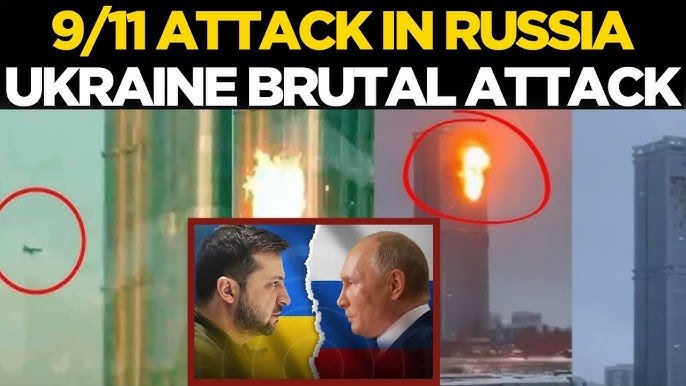Ukraine Strikes Russian High-Rises in Kazan – A 9/11-Like Attack
Introduction: Ukraine Targets Russian High-Rises in Kazan
In a significant escalation of the ongoing conflict, Ukrainian forces have launched an airstrike targeting high-rise buildings in Kazan, Russia, mirroring the strategic impact of the 9/11 attacks. This bold move comes as part of Ukraine’s continued resistance against Russia’s military operations. The precision and intensity of the attack have raised concerns over the broader implications of such strikes in urban areas and their potential to escalate tensions between the two nations.
Details of the Attack
Ukrainian missile strikes hit multiple high-rise towers in the Russian city of Kazan, leaving a trail of destruction and sparking intense fire outbreaks in several buildings. Witnesses described the attack as a near-replica of the September 11, 2001, strikes in the United States, as the buildings crumbled under the impact of the blasts. The strike has drawn international attention, both for its destructive scale and the apparent shift in Ukraine’s military strategy.
Strategic Significance of the Attack
The assault on Kazan’s high-rises serves as a clear message from Ukraine to Russia. This act of aggression is seen as a retaliation for Russia’s continued military aggression against Ukraine. By targeting urban centers, Ukraine is challenging Russia’s military might on its home turf, intensifying the conflict and perhaps altering the dynamics of the war. This shift in tactics also highlights Ukraine’s evolving defense strategies, which increasingly focus on strategic targets within Russia’s major cities.

Why This News Is Important
Impact on the Ongoing Conflict
The Ukrainian strike on Kazan’s high-rises marks a significant turning point in the Russia-Ukraine war. The precision and destruction of the attack indicate a new phase in Ukraine’s military strategy, where it moves beyond defensive measures and directly targets key Russian urban centers. This escalation may provoke further military actions from Russia, leading to an intensification of the conflict that could spill over into other parts of Europe.
Global Security Concerns
This attack has heightened concerns about global security, especially in relation to urban warfare and its impact on civilian populations. With the use of airstrikes on high-rise buildings, there are fears of widespread civilian casualties and the potential for the conflict to spiral into an all-out war, involving more countries and international powers. The incident brings the global community into a crucial debate over the ethics of such military tactics and the long-term consequences for urban infrastructure.
Impact on International Relations
The strike on Kazan also has the potential to alter Russia’s international relations. Countries aligned with Russia might feel pressured to support it more overtly, while others could ramp up their aid and military support to Ukraine. This event may prompt international bodies, such as the United Nations and NATO, to take a stronger stance in efforts to mediate peace or address the consequences of such attacks.
Historical Context: Background Information on the Conflict
Russia-Ukraine War Background
The Russia-Ukraine war, which began in 2014 with Russia’s annexation of Crimea, has escalated significantly in recent years. The conflict grew into a full-scale war in 2022 when Russia launched a large-scale military invasion of Ukraine, leading to widespread destruction and significant loss of life. Ukraine has been receiving support from Western countries, particularly in the form of military aid, which has bolstered its defense against Russian forces.
The Significance of Urban Warfare
The targeted strike on high-rise buildings in Kazan brings into focus the growing significance of urban warfare in modern conflicts. Urban areas, with dense populations and strategic infrastructure, are increasingly being utilized as key battlefronts. While these tactics are not new, their use in high-profile targets like the Kazan high-rises demonstrates a shift in the nature of warfare, with greater emphasis on crippling enemy morale and economic infrastructure.
Key Takeaways from “Ukraine Strikes Russian High-Rises in Kazan – A 9/11-Like Attack”
| # | Key Takeaway |
|---|---|
| 1 | Ukrainian missile strikes targeted high-rise buildings in Kazan, Russia. |
| 2 | The attack is compared to the 9/11 attacks in the U.S. due to its scale. |
| 3 | This strike marks a shift in Ukraine’s military strategy, targeting urban centers in Russia. |
| 4 | The attack raises global concerns about urban warfare and its humanitarian impact. |
| 5 | The strike could lead to intensified military action and alter international relations. |
Important FAQs for Students from this News
What was the recent strike carried out by Ukraine in Russia?
- Ukraine launched a missile strike on high-rise buildings in Kazan, Russia, mirroring the scale and impact of the 9/11 attacks. This marked a significant escalation in the ongoing Russia-Ukraine war.
Why is the Ukrainian strike on Kazan being compared to the 9/11 attacks?
- The strike is compared to the 9/11 attacks due to the scale of destruction caused to the high-rise buildings, which collapsed under the impact of the missiles, resembling the impact of the 9/11 attacks on the World Trade Center towers.
How has this attack changed Ukraine’s military strategy?
- The attack signifies a shift in Ukraine’s military tactics, moving from defensive strategies to actively targeting key urban centers in Russia. This could escalate the conflict further by targeting civilian infrastructure.
What are the global implications of this attack?
- The strike has raised concerns about urban warfare, the potential for civilian casualties, and the risk of further escalation in the Russia-Ukraine conflict. It also increases international pressure on both Russia and Ukraine, especially in the context of global security.
What are the key takeaways from the attack on Kazan?
- The key takeaways include the nature of the strike targeting high-rise buildings, its comparison to 9/11, a shift in Ukraine’s military strategy, global security concerns, and potential changes in international relations.
Some Important Current Affairs Links


















